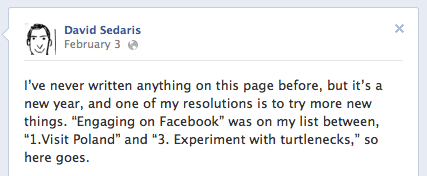The Blog Library
Having Trouble Writing About Yourself? Try This.
Have you ever been on a first date where your conversation glided from topic to topic, peppered with one “no way – me too!” after another?
Smiling and stirring your water glass absentmindedly with a straw as you discovered all the things you have in common? It’s this magical feeling where the big things in common make you seem “meant to be” (“you studied in India? me too!”) and even the small things seem endearing (“I go to that same Jiffy Lube!”). Whether or not that person turned out to be Mr. or Mrs. Right, it sure feels like it in the moment.
This is not going to come as a surprise, but: We tend to like people who are similar to us.
Whether it’s in background, dress, lifestyle, habits, hometown, brand of toothpaste used – there is a comfort and reassurance in being around someone who has something in common. Of course, there are major problems that come from this (e.g. cliquishness, suspicion or dislike of “the others”), but similarity is also a quick and pleasant way to connect with a stranger.
 Similarity isn’t just powerful in making a nice connection on a magical first date or in a pleasant conversation with an airplane seatmate. Feeling similar to someone also affects how willing we are to help or buy from someone.
Similarity isn’t just powerful in making a nice connection on a magical first date or in a pleasant conversation with an airplane seatmate. Feeling similar to someone also affects how willing we are to help or buy from someone.
In the 1970s, researchers had some people dress up in either a conservative or a “hippie” style, then go to a college campus and ask strangers for a dime to make a phone call.
When the dime-requester and the college students were dressed similarly, the dime was given more than two-thirds of the time. When they weren’t dressed similarly, they gave the dime less than half the time. Obviously, similarity of dress wasn’t the only factor, but it still made a substantial difference in a person’s chances of making that phone call.
We see the same phenomenon in sales. For example, one study showed that people were more likely to buy insurance from those similar to them in age, religion, and political views.
Objectively speaking, this makes no sense – a salesman’s world view shouldn’t impact whether or not you need insurance. Yet feeling similar to the salesman may make it easier to like them, feel comfortable with them, or trust that they understand your particular situation and know what’s best. In short, similarity isn’t just a social nicety, it affects how we take action with those around us.
Photographers consistently miss chances to show natural similarities, which means they’re losing out on powerful connections that make clients comfortable.
Sure, we’re seeing much more of a trend to build a personal ‘brand,’ write personal posts, and share stories in our bios. All of this is great. But there’s another simple way to show a little more of yourself in writing (without needing to get too personal) that allows clients to see similarities that already exist:
Drop concrete details, even in passing.
A salesman isn’t sitting down and giving customers his/her entire bio. They’re dropping casual, concrete details into the conversation, like “Oh you just drove in from Montana? I visited there every summer as a boy.” And suddenly, without any fanfare or tremendous effort, there’s a connection.
You can do the same thing in writing.
Obviously, we should never fabricate similarities to get people’s attention. Remember the character Will in About A Boy, who invented a 2-year-old son to get the attention of single moms? Yeah, don’t do that. Your goal is to just drop in a few true-story ideas here and there in what you’re already writing.
Let’s say you’re a mom, and you’re also a family photographer. There are a lot of day-to-day things you and your clients have in common, things that that can make them feel understood. You don’t have to write entire posts about cleaning up spaghetti or chasing a rogue, diaperless child through the house to achieve this (though you definitely could). You can also drop tiny concrete details into things you’re already writing, in ways that makes your writing more interesting.
For example, on your blog, instead of saying “yesterday, I was thinking about _____.” you might try: “Yesterday, in between shuttling kids from piano to soccer, I was thinking about ____.”
Just a small little slice of background, a tiny real-life detail like that can help a client smile and think “Yep, me too.”
While browsing tasty recipes the other day, I saw a funny example of this concept. A food blogger was sharing a recipe for salted brown butter crispy treats (which, by the way, are awesome). While introducing the recipe, she tossed in an unexpected, adorable photo of her son by way of jokingly explaining why she hadn’t gotten the recipe up sooner. I don’t know this blogger, but this tiny little hint of her life outside the blog made me happy and want to read more.
Writer and storyteller David Sedaris recently posted something on his Facebook page that illustrates the same idea:

How much can you tell about him from that brief snippet? It’s at least a lot more interesting and less generic than “I’ve never written anything on this page before, but here goes.”
You’ll want to consider your target client as you do this, of course.
If you’re not marketing to moms, details about dropping kids off could seem irrelevant to the conversation, and might just be confusing. The goal isn’t to take away from the conversation or get off topic, but to offer a little familiar context. We often ignore the mundane aspects of our day-to-day, but sharing snippets here and there can make someone feel connected.
Music, TV, movies, travel, what state our cousins live in, favorite types of candy, guilty pleasures – all of these can become touch points, super brief hints we sprinkle into regular conversation that give our target clients the chance to say “Me too.”
And the great thing is, even if the reader doesn’t share that exact same thing, you’re still making your writing more concrete and easily visualized (see the David Sedaris example). Which, as we’ve talked about before, makes your writing more memorable and interesting. (Remember the 7-Minute Website Writing Makeover?)
By the way: If you glance back, you’ll see that I illustrate this “concrete details” principle right in this post. Even though I’ve been talking about writing, clients, and “similarity,” you can probably also glean that I love making desserts, follow humorously insightful authors on Facebook, and have seen way too many Hugh Grant rom-coms.
Tiny hints. Little examples. Bits of context. That’s all it takes.
‘Similarity’ is not about superficially squealing “oh me too!” by way of getting people to like you.
It’s about thinking through who you are and how you’re allowing clients to relate to you (or not).
Like it or not, most clients will meet you online before they meet you in person. This means you have to translate a few of those “first date magic moments” into writing (or photos) so people can connect with you through your web presence. Try dropping in a pinch of background, context, or detail into your next blog post, and see what happens.
People want to find stuff they have in common with you. It feels better than dealing with an unknown stranger. By allowing them little chances to say “me too,” you’re making your web presence a friendlier space that will create more connections.
P.S. For more ideas about how to connect with clients online, you might check out the How To Build An Absolutely Irresistible Photography Website e-book.





Oh I have been struggling with this so much! Thank you!
Jenika,
You’re amazing. I had a flash after I read this and just updated my bio…again…lol! It’s always a work in progress but this has helped tremendously!!!
Great post. It’s a good reminder that we should all let our personalities shine through even when we’re writing for professional purposes. After a decade-long career in banking, I sometimes forget that I’m an artist now, and I can let my quirky side show.
I’m always surprised at how often my readers tell me they love hearing about & seeing photos of my dogs. Just when I assume they’ve had enough, they’re asking for more. This post reassures that they like relating to me.
I struggle with this so much, really good article.. thank you I’ve been trying to keep work/personal life seperate maybe just maybe I might start to let clients in 🙂
Thanks James! There are legit reasons to keep personal and work life separate, I’m with you there. I hope you’re able to find a handful of things that might connect you with your audience – it may surprise you what happens. Thanks for the comment!
🙂
As I live and breathe, some very good advice to us all. I shall have a read through my website and see what of myself I’m sharing that might be nice to see from a prospective customer’s perspective. Thank you. Si.
From a business point of view yes, I agree you need to make connections by sharing a bit of yourself. There is so much choice out there for most trades and businesses, that people buy from someone who they connect with. Although there is also the case for not being too open, be careful what you post on social media sites, a photo from a night out might look funny at the time. Might not be so good the morning after. Also from a security point of view, giving away too much info does open you up to identity thieves.
Sure, those concerns are absolutely valid. There’s lots of stuff I avoid putting online to avoid identity theft. And picture-screening is definitely a vital skill – not just on your business facebook, but your personal page as well 🙂 I just hope in our efforts to screen what we put up, we don’t sanitize our personalities …. it’s the bits of human context that create that connection, as you said.